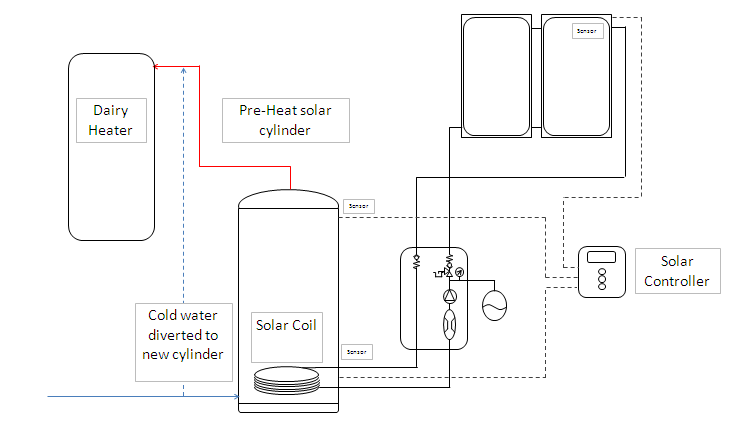- Home
- Knowledge library
- Incorporate solar water heating
Incorporate solar water heating
How to use solar heating panels to help heat water, including types of heat exchanger and key installation points to consider.
Back to: How to ensure energy efficient water heating on dairy farms
Solar water heating panels, like heat recovery, can provide some of the heat for the water, although it is unlikely to produce the temperature required for plant washing.
Solar systems are available which can produce water temperatures of between 40°C and 60°C. Clearly there’s more energy available through the summer months than in the winter, and it’s only available during daylight hours. However, solar thermal systems function effectively even at low ambient temperatures and hot water can be stored for later use, so it’s more flexible than would first seem apparent.
Energy and economic potential
Before considering solar thermal as a water heating option it’s worth assessing the application of heat recovery units. If these are in place then the benefits of solar thermal will be much less, and vice versa.
With applications such as system cleaning (temperature over 85°C), and where no heat recovery unit is in place, solar thermal systems will contribute around half of the energy required per year.
Solar contributing 50% (7,200 kWh) to a system heating 400 litres of water to 95°C per day would avoid £800 worth of electricity on low rate or £1,225 on higher rate tariff.
Types of solar thermal collectors
Flat plate collectors use a panel absorber positioned just below a sheet of glass which transfers to a liquid that is pumped through the system. These are simple, cheap systems but might struggle to perform well at lower ambient temperatures.
Evacuated Tubes are glass vacuum tubes containing strips of twisted metal which act as absorbers for solar radiation. The vacuum prevents heat conduction losses to the atmosphere so heat transfer to the circulated water is very efficient. Tube systems are more expensive than plate collectors.
What to consider when installing solar
Optimal siting would be on a south facing roof or other structure at an angle of 35 degrees (20 to 50 degrees) to the horizontal and free from shading. Solar collectors can also be ground mounted on frames. The system should be located as close as possible to stored hot water cylinders.
Because of the need to heat water to a higher temperature with a secondary system, it’s usually best to have a separate solar heated tank and use this to act as a ‘header’ tank feeding the final hot water cylinder. This stops the possibility of the solar heated tanks holding water at a temperature above the delivery temperature of the solar system and therefore preventing it working correctly.
Thermal solar panels are heavier than PV panels so a structural survey should first be carried out on any residential property or farm building and the roof structure strengthened if required.

Figure 2: A typical layout of a solar hot water system.
Other renewable energy options
Although a biomass boiler can be used for water heating it’s seldom worth installing a biomass boiler for water heating alone. If however a biomass boiler can be shared with some other application, like domestic heating or commercial process use such as grain drying, then it may be worthwhile considering integrating requirements.

